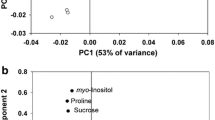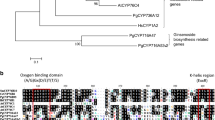Abstract
In recent years, environmental pollutants such as pesticide residues have become one of the severe public problems that endanger the ecological environment and affect human health. The development of biotechnology to rapidly and efficiently degrade pesticides is essential to reduce their environmental risks. Azoxystrobin (AZ) is representative of the most widely used agricultural fungicide in the world. A large number of studies have shown that AZ has toxic effects on non-target organisms such as fish, algae, earthworms, etc., which may pose a potential threat to the environmental ecosystem. Therefore, it is particularly important to develop new AZ phytoremediation methods. Based on the constructed Arabidopsis UGT72E2 knockout (KO) and overexpression (OE) lines, this study found that overexpression of UGT72E2 in Arabidopsis can enhance resistance to exogenous AZ stress and maintain a relatively stable physiological state while enhancing the metabolic degradation of AZ. Correspondingly, knockout mutants showed the opposite results. The results showed that the AZ glycosylation and malonyl glycosylation products produced by UGT72E2 overexpression lines increased by 10%~20% compared with normal lines, and increased by 7%~47% compared with gene knockout plants, and exhibited lower phytotoxicity. In summary, our findings highlight the critical role of UGT72E2 overexpression in constructing new varieties of phytoremediation and may provide new ideas for reducing the indirect or direct risks of pesticides or other environmental pollutants to non-target organisms and improving biological and environmental resilience.
Graphical abstract





Similar content being viewed by others
Data availability
The datasets used or analyzed during the current study are available from the corresponding author on reasonable request.
References
Adetutu EM, Ball AS, Osborn AM (2008) Azoxystrobin and soil interactions: degradation and impact on soil bacterial and fungal communities. J Appl Microbiol 105:1777–1790
Alkorta I, Garbisu C (2001) Phytoremediation of organic contaminants in soils. Bioresour Technol 79:273–276
Aparicio JD, Raimondo EE, Saez JM, Costa-Gutierrez SB, Álvarez A, Benimeli CS, Polti MA (2022) The current approach to soil remediation: a review of physicochemical and biological technologies, and the potential of their strategic combination. Journal of Environmental. Chem Eng 10
Apel K, Hirt H (2004) Reactive oxygen species: metabolism oxidative stress and signal transduction. Annu Rev Plant Biol 55(1):373–399. https://doi.org/10.1146/annurev.arplant.55.031903.141701
Awasthi SK, Kumar M, Kumar V, Sarsaiya S, Anerao P, Ghosh P, Singh L, Liu H, Zhang Z, Awasthi MK (2022) A comprehensive review on recent advancements in biodegradation and sustainable management of biopolymers. Environ Pollut 307:119600
Bacmaga M, Wyszkowska J, Kucharski J (2017) Bioaugmentation of Soil Contaminated with Azoxystrobin. Water Air Soil Pollut 228:19
Barnes JD, Balaguer L, Manrique E, Elvira S, Davison AW (1992) A reappraisal of the use of DMSO for the extraction and determination of chlorophylls a and b in lichens and higher plants. Environmental and Experimental Botany 32:85–100
Bending GD, Rodriguez-Cruz MS, Lincoln SD (2007) Fungicide impacts on microbial communities in soils with contrasting management histories. Chemosphere 69:82–88
Boriboonkaset T, Theerawitaya C, Yamada N, Pichakum A, Supaibulwatana K, Cha-Um S, Takabe T, Kirdmanee C (2013) Regulation of some carbohydrate metabolism-related genes, starch and soluble sugar contents, photosynthetic activities and yield attributes of two contrasting rice genotypes subjected to salt stress. Protoplasma 250:1157–1167
Chen L, Huang XX, Zhao SM, Xiao DW, Xiao LT, Tong JH, Wang WS, Li YJ, Ding Z, Hou BK (2020) IPyA glucosylation mediates light and temperature signaling to regulate auxin-dependent hypocotyl elongation in Arabidopsis. Proc Natl Acad Sci U S A 117:6910–6917
Clough SJ, Bent AF (1998) Floral dip: a simplified method forAgrobacterium-mediated transformation of Arabidopsis thaliana. Plant J 16(6):735–743. https://doi.org/10.1046/j.1365-313x.1998.00343.x
Del Buono D, Terzano R, Panfili I, Bartucca ML (2020) Phytoremediation and detoxification of xenobiotics in plants: herbicide-safeners as a tool to improve plant efficiency in the remediation of polluted environments. A mini-review. Int J Phytoremediation 22:789–803
Deng XY, Cheng J, Hu XL, Wang L, Li D, Gao K (2017) Biological effects of TiO2 and CeO2 nanoparticles on the growth, photosynthetic activity, and cellular components of a marine diatom Phaeodactylum tricornutum. Sci Total Environ 575:87–96
Doganlar ZB (2012) Physiological and genetic responses to pesticide mixture treatment of Veronica beccabunga. Water Air Soil Pollut 223(9):6201–6212
Eapen S, Singh S, D'Souza SF (2007) Advances in development of transgenic plants for remediation of xenobiotic pollutants. Biotechnol Adv 25:442–451
Edwards R, Dixon DP, Cummins I, Brazier-Hicks M, Skipsey M (2011): New perspectives on the metabolism and detoxification of synthetic compounds in plants. In: Schröder P , Collins CD (Editors), Organic xenobiotics and plants: from mode of action to ecophysiology. Springer Netherlands, Dordrecht, pp. 125-148
European Food Safety Authority (EFSA) (2007) European Food Safety Authority, Parma, Italy
FAO (2006) Food and Agriculture Organization of the United Nations – THIACLOPRID JMPR no. (223). http://www.fao.org/fileadmin/templates/agphome/documents/Pests_Pesticides/JMPR/valuation06/Thiacloprid06.pdf. Accessed 23 Jan 2017
Gachon CM, Langlois-Meurinne M, Saindrenan P (2005) Plant secondary metabolism glycosyltransferases: the emerging functional analysis. Trends Plant Sci 10:542–549
Hou DY, O'Connor D, Igalavithana AD, Alessi DS, Luo J, Tsang DCW, Sparks DL, Yamauchi Y, Rinklebe J, Ok YS (2020) Metal contamination and bioremediation of agricultural soils for food safety and sustainability. Nat Rev Earth Env 1:366–381
Huang XX, Zhu GQ, Liu Q, Chen L, Li YJ, Hou BK (2018) Modulation of plant salicylic acid-associated immune responses via glycosylation of dihydroxybenzoic acids. Plant Physiol 176:3103–3119
Huang XX, Zhao SM, Zhang YY, Li YJ, Shen HN, Li X, Hou BK (2021) A novel UDP-glycosyltransferase 91C1 confers specific herbicide resistance through detoxification reaction in Arabidopsis. Plant Physiol Biochem 159:226–233
Jones P, Vogt T (2001) Glycosyltransferases in secondary plant metabolism: tranquilizers and stimulant controllers. Planta 213:164–174
Ju C, Zhang H, Yao S, Dong S, Cao D, Wang F, Fang H, Yu Y (2019) Uptake, translocation, and subcellular distribution of azoxystrobin in wheat plant ( Triticum aestivum L.). J Agric Food Chem 67:6691–6699
Kim M-G, Hwang K-W, Hwang E-j, Yoo SC, Moon J-K (2017) Absorption of soil residual azoxystrobin to lettuce. J Appl Biol Chem 60:343–349
Kumar K, Shinde A, Aeron V, Verma A, Arif NS (2022a) Genetic engineering of plants for phytoremediation: advances and challenges. J Plant Biochem Biot 32(1):12–30
Kumar L, Chugh M, Kumar S, Kumar K, Sharma J, Bharadvaja N (2022b) Remediation of petrorefinery wastewater contaminants: a review on physicochemical and bioremediation strategies. Process Saf Environ Protect 159:362–375
Li Y, Baldauf S, Lim EK, Bowles DJ (2001) Phylogenetic analysis of the UDP-glycosyltransferase multigene family of Arabidopsis thaliana. J Biol Chem 276:4338–4343
Li P, Li YJ, Zhang FJ, Zhang GZ, Jiang XY, Yu HM, Hou BK (2017) The Arabidopsis UDP-glycosyltransferases UGT79B2 and UGT79B3, contribute to cold, salt and drought stress tolerance via modulating anthocyanin accumulation. Plant J 89:85–103
Livak KJ, Schmittgen TD (2001) Analysis of relative gene expression data using real-time quantitative PCR and the 2(-Delta Delta C(T)) Method. Methods 25:402–408
Lu FF, Xu JY, Ma LY, Su XN, Wang XQ, Yang H (2018) Isoproturon-induced salicylic acid confers Arabidopsis resistance to isoproturon phytotoxicity and degradation in plants. J Agric Food Chem 66:13073–13083
McDougall J (2015) In the home of the famous dead collected poems. University of Arkansas. https://doi.org/10.2307/j.ctt1ffjgxg2015
Mohapatra S, Siddamallaiah L, Matadha NY (2021) Behavior of acetamiprid, azoxystrobin, pyraclostrobin, and lambda-cyhalothrin in/on pomegranate tissues. Environ Sci Pollut Res Int 28:27481–27492
Petit AN, Fontaine F, Vatsa P, Clement C, Vaillant-Gaveau N (2012) Fungicide impacts on photosynthesis in crop plants. Photosynth Res 111:315–326
Pulford ID, Watson C (2003) Phytoremediation of heavy metal-contaminated land by trees--a review. Environ Int 29:529–540
Romeh AA (2015) Evaluation of the phytoremediation potential of three plant species for azoxystrobin-contaminated soil. Int J Environ Sci Technol 12:3509–3518
Sahu PK, Tilgam J, Mishra S, Hamid S, Gupta A, Verma SK, Kharwar RN (2022) Surface sterilization for isolation of endophytes: ensuring what (not) to grow. J Basic Microbiol 62:647–668
Saladin G, Clément C (2005) Physiological side effects of pesticides on non-targer plants. In: Livingston JV (ed) Agriculture and soil pollution: new research. Nova Science Publishers, Inc.
Sarkar B, Dissanayake PD, Bolan NS, Dar JY, Kumar M, Haque MN, Mukhopadhyay R, Ramanayaka S, Biswas JK, Tsang DCW, Rinklebe J, Ok YS (2022) Challenges and opportunities in sustainable management of microplastics and nanoplastics in the environment. Environ Res 207:112179
Scott C, Pandey G, Hartley CJ, Jackson CJ, Cheesman MJ, Taylor MC, Pandey R, Khurana JL, Teese M, Coppin CW, Weir KM, Jain RK, Lal R, Russell RJ, Oakeshott JG (2008) The enzymatic basis for pesticide bioremediation. Indian J Microbiol 48:65–79
Sharma A, Kumar V, Shahzad B, Tanveer M, Sidhu GPS, Handa N, Kohli SK, Yadav P, Bali AS, Parihar RD, Dar OI, Singh K, Jasrotia S, Bakshi P, Ramakrishnan M, Kumar S, Bhardwaj R, Thukral AK (2019) Worldwide pesticide usage and its impacts on ecosystem. Sn Appl Sci 1
Speeckaert N, El Jaziri M, Baucher M, Behr M (2022) UGT72, a major glycosyltransferase family for flavonoid and monolignol homeostasis in plants. Biology 11:441
Sun J, Pan L, Tsang DCW, Zhan Y, Zhu L, Li X (2018) Organic contamination and remediation in the agricultural soils of China: a critical review. Sci Total Environ 615:724–740
Szabados L, Savoure A (2010) Proline: a multifunctional amino acid. Trends Plant Sci 15:89–97
Vamerali T, Bandiera M, Mosca G (2010) Field crops for phytoremediation of metal-contaminated land. A review. Environ Chem Lett 8:1–17
Wu J, Zhu W, Shan X, Liu J, Zhao L, Zhao Q (2022) Glycoside-specific metabolomics combined with precursor isotopic labeling for characterizing plant glycosyltransferases. Molecular Plant 15:1517–1532
Yan M-W, Xing X-R, Wu F-A, Wang J, Sheng S (2021) UDP-glycosyltransferases contribute to the tolerance of parasitoid wasps towards insecticides. Pestic Biochem Physiol 179:104967
Yan C, Qu Z, Wang J, Cao L, Han Q (2022) Microalgal bioremediation of heavy metal pollution in water: recent advances, challenges, and prospects. Chemosphere 286:131870
Yu G, Chen Q, Chen F, Liu H, Lin J, Chen R, Ren C, Wei J, Zhang Y, Yang F, Sheng Y (2022) Glutathione promotes degradation and metabolism of residual fungicides by inducing UDP-glycosyltransferase genes in tomato. Front Plant Science 13
Zambito Marsala R, Capri E, Russo E, Bisagni M, Colla R, Lucini L, Gallo A, Suciu NA (2020) First evaluation of pesticides occurrence in groundwater of Tidone Valley, an area with intensive viticulture. Sci Total Environ 736:139730
Zayed A, Pilon-Smits E, deSouza M, Lin ZQ, Terry N (1997) Remediation of selenium-polluted soils and waters by phytovolatilization, symposium on phytoremediation of trace elements in contaminated soil and water at the 4th International Conference on the Biogeochemistry of Trace Elements. Univ Ca Berkeley, Berkeley, Ca, pp 61–83
Zhang Z, Ke M, Qu Q, Peijnenburg W, Lu T, Zhang Q, Ye Y, Xu P, Du B, Sun L, Qian H (2018) Impact of copper nanoparticles and ionic copper exposure on wheat (Triticum aestivum L.) root morphology and antioxidant response. Environ Pollut 239:689–697
Funding
This work was supported by the National Key Research and Development Program of China (2021YFD2201000, 2019YFA0903900); National Natural Science Foundation of China (31870273); and Shenzhen Key Laboratory of Synthetic Genomics (ZDSYS201802061806209).
Author information
Authors and Affiliations
Contributions
Yu Wang: conceptualization, methodology, investigation, writing—original draft; Jie Wu: investigation; supervision; Lingling Zhao: investigation; Wei Sun: investigation; Sen Yan: investigation; Sinuo Tian: investigation; Qiao Zhao: supervision; funding acquisition; Wentao Zhu: conceptualization, supervision.
Corresponding author
Ethics declarations
Ethics approval and consent to participate
Not applicable
Consent for publication
Not applicable
Competing interests
The authors declare no competing interests.
Additional information
Responsible Editor: Gangrong Shi
Publisher’s note
Springer Nature remains neutral with regard to jurisdictional claims in published maps and institutional affiliations.
Supplementary information
Rights and permissions
Springer Nature or its licensor (e.g. a society or other partner) holds exclusive rights to this article under a publishing agreement with the author(s) or other rightsholder(s); author self-archiving of the accepted manuscript version of this article is solely governed by the terms of such publishing agreement and applicable law.
About this article
Cite this article
Wang, Y., Wu, J., Zhao, L. et al. A powerful helper of azoxystrobin degradation—the unique mechanism of UGT72E2 promoting environmental degradation of azoxystrobin. Environ Sci Pollut Res 30, 87588–87598 (2023). https://doi.org/10.1007/s11356-023-28343-w
Received:
Accepted:
Published:
Issue Date:
DOI: https://doi.org/10.1007/s11356-023-28343-w




